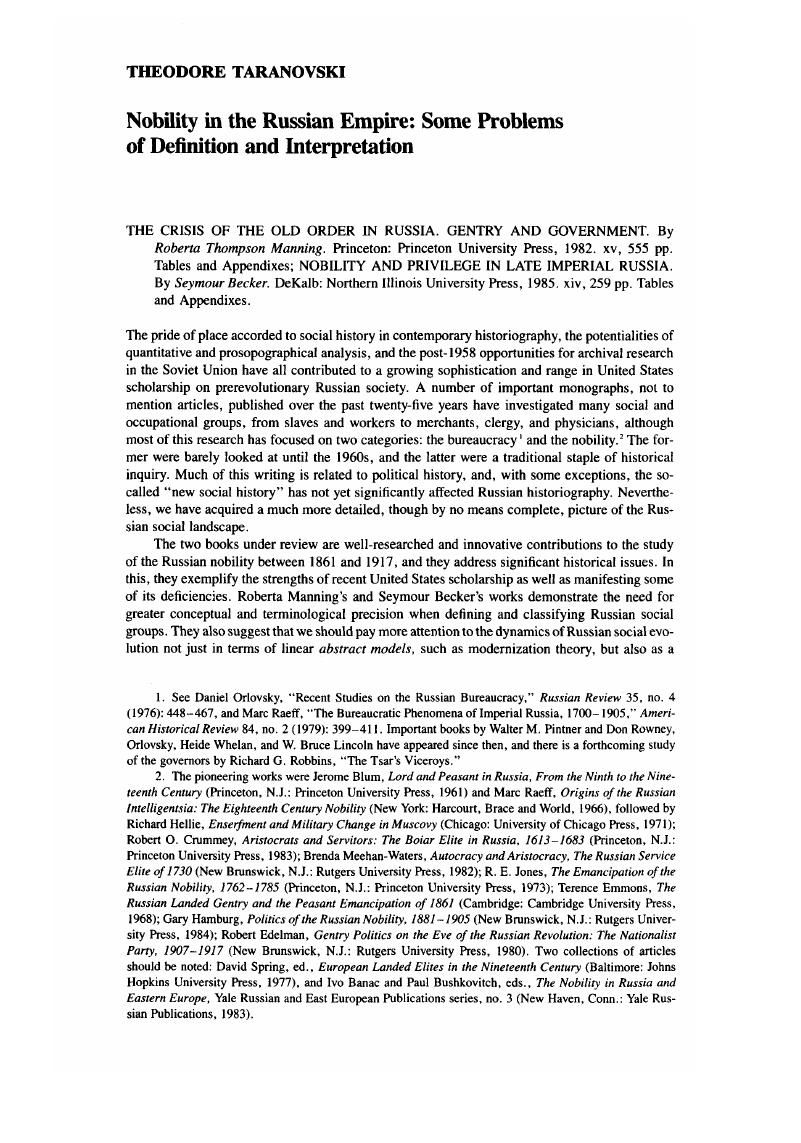Article contents
Nobility in the Russian Empire: Some Problems of Definition and Interpretation - The Crisis of the Old Order in Russia. Gentry and Government. By Roberta Thompson Manning. Princeton: Princeton University Press, 1982. xv, 555 pp. Tables and Appendixes; Nobility and Privilege in Late Imperial Russia. By Seymour Becker. DeKalb: Northern Illinois University Press, 1985. xiv, 259 pp. Tables and Appendixes.
Published online by Cambridge University Press: 27 January 2017
Abstract

- Type
- Review Articles
- Information
- Copyright
- Copyright © Association for Slavic, East European, and Eurasian Studies. 1988
References
1. See Daniel Orlovsky, “Recent Studies on the Russian Bureaucracy,” Russian Review 35, no. 4 (1976): 448–467, and Marc Raeff, “The Bureaucratic Phenomena of Imperial Russia, 1700–1905,” AmericanHistorical Review 84, no. 2 (1979): 399–411. Important books by Walter M. Pintner and Don Rowney, Orlovsky, Heide Whelan, and W. Bruce Lincoln have appeared since then, and there is a forthcoming studyof the governors by Richard G. Robbins, “The Tsar's Viceroys. “
2. The pioneering works were Blum, Jerome, Lord and Peasant in Russia, From the Ninth to the Nineteenth Century (Princeton, N.J.: Princeton University Press, 1961)Google Scholar and Raeff, Marc, Origins of the Russian Intelligentsia: The Eighteenth Century Nobility (New York: Harcourt, Brace and World, 1966)Google Scholar, followed by Hellie, Richard, Enserfment and Military Change in Muscovy (Chicago: University of Chicago Press, 1971 CrossRefGoogle Scholar; Crummey, Robert O., Aristocrats and Servitors: The Boiar Elite in Russia, 1613–1683 (Princeton, N.J.: Princeton University Press, 1983)CrossRefGoogle Scholar; Meehan-Waters, Brenda, Autocracy and Aristocracy, The Russian Service Elite of 1730 (New Brunswick, N.J.: Rutgers University Press, 1982)Google Scholar; Jones, R. E., The Emancipation of the Russian Nobility, 1762–1785 (Princeton, N.J.: Princeton University Press, 1973)Google Scholar; Emmons, Terence, TheRussian Landed Gentry and the Peasant Emancipation of 1861 (Cambridge: Cambridge University Press, 1968 Google Scholar; Hamburg, Gary, Politics of the Russian Nobility, 1881–1905 (New Brunswick, N. J.: Rutgers University Press, 1984)Google Scholar; Edelman, Robert, Gentry Politics on the Eve of the Russian Revolution: The NationalistParty, 1907–1917 (New Brunswick, N.J.: Rutgers University Press, 1980)Google Scholar. Two collections of articlesshould be noted: Spring, David, ed., European Landed Elites in the Nineteenth Century (Baltimore: JohnsHopkins University Press, 1977 Google Scholar, and Banac, Ivo and Bushkovitch, Paul, eds., The Nobility in Russia and Eastern Europe, Yale Russian and East European Publications series, no. 3 (New Haven, Conn.: Yale Russian Publications, 1983)Google Scholar.
3. Compare Rhiman A. Rotz, “Class Structure, Western (1300–1500),” in Strayer, Joseph R., ed., Dictionary of the Middle Ages (New York: Scribner, 1982) 3: 419–429 Google Scholar, for an example of this approach.
4. Duby, George, The Three Orders: Feudal Society Imagined (Chicago: University of Chicago Press, 1980).Google Scholar
5. Freeze, Gregory, “The Soslovie (Estate) Paradigm and Russian Social History,” American HistoricalReview 91, no. 1 (1986): 11–36 CrossRefGoogle Scholar, is a sensitive and learned treatment of the question, although not convincingin all particulars.
6. Polovtsov, Aleksandr A., Dnevnik (Moscow, 1966) 1: 314–315.Google Scholar
7. Cited in Solov'ev, Iurii B., Samoderzhavie i dvorianstvo v kontse XIX veka (Leningrad: Nauka, 1973), p. 301.Google Scholar
- 5
- Cited by




